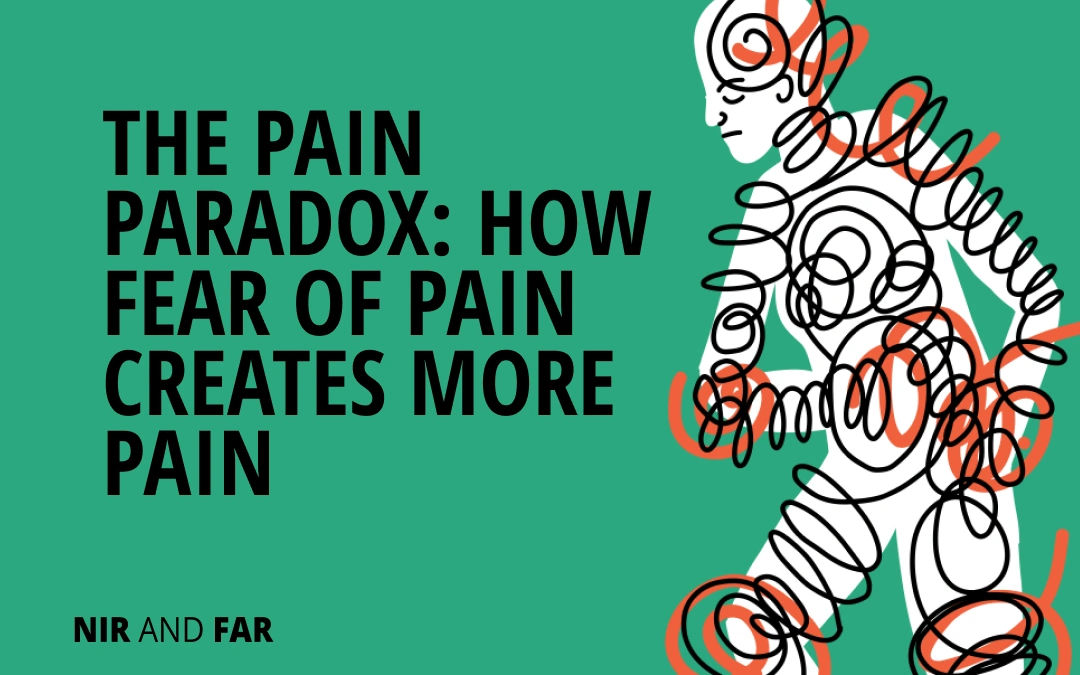Taming your overprotective brain
In the opening shot of the music video for “Throw Some Ass,” the camera scans a clinical white sign: “Sofi Tukker Center for Asses That Don’t Move Good.” Inside the mock hospital, a heart monitor flatlines—until the beat drops. Suddenly, the music video erupts into a NSFW riot of sensual movement. To fans, the song is a catchy ode to booty shaking, but to Sophie Hawley-Weld, one half of electronic music duo Sofi Tukker, it was a revelation of her journey through chronic pain and the power of the mind.
In 2018, Sophie and Tucker Halpern were in the middle of a whirlwind year—releasing their first (later Grammy-nominated) album, launching their own record label, and headlining tours—when Sophie began to have chronic migraines.
“We were full-time touring … there was so much happening,” Sophie explained on the podcast Like Mind, Like Body. “We were going out five nights a week. We were traveling way crazier than we are now … Because our career was so new, we said yes to every opportunity, and it put our bodies through a strain. I didn’t do the simple things as well, like take a walk and go get sunlight, all these things I’ve learned how to do since this [pain]. So my body was really confused.”
For the next year and a half, Sophie endured debilitating chronic migraines that forced her to retreat to dark rooms. “I was having to cancel shows, and nothing was working.”
Later, back pain created a destructive cycle when traditional medical approaches failed. She tried every drug and treatment she could find, but they didn’t work. Doctors recommended cortisone injections for her back, which only intensified her fear and worsened her condition—a phenomenon well-documented in pain studies.
As a performing artist, her inability to move without pain didn’t just affect her health; it jeopardized her thriving career.
Yet today, Sophie has been nearly pain-free for almost seven months. How did she get there?
Predicting Pain
Sophie says that her back pain started out of the blue. “Maybe there was an injury associated with it”—Sophie’s healing journey led her to discover that she’s hypermobile and has to be careful doing certain exercises—“but … I don’t think [the pain] was that intense to begin with. I was just like, ‘What is this weird thing? This is weird. Oh, this is weird weird. Weird weird weird weird!’
“The more I was focusing on the pain and trying to make the pain go away, and obsessing over the pain, the pain got worse,” she recalled, describing what pain specialists recognize as the “pain-fear-pain cycle.” The more she anticipated pain, the worse it became—a classic example of the brain’s predictions creating the very suffering they warn against.
Sophie’s story illustrates a profound truth: All pain is real, but not all pain is necessary.
Pain isn’t in your tissues, but in your brain. It’s meant to be the brain’s way of protecting the body from harm. When you touch a hot stove, for example, danger receptors in your finger send signals so you pull your hand away fast. But your brain creates the experience of pain. This distinction is crucial for understanding chronic pain, which often persists long after tissues have healed.
Research increasingly suggests many chronic pain conditions result from “neuroplastic pain,” pain maintained by the brain’s predictions rather than ongoing tissue injury. Pain psychologist Alan Gordon explains, “The brain learns to predict pain to protect you. But sometimes these predictions become overprotective, warning you of danger even when there’s no tissue damage occurring.”
In normal pain processing, our bodies follow a straightforward path:
Normal Pain Process:

This is how we learn not to touch hot stoves after being burned once. The process is adaptive and protective.
But for millions of chronic pain sufferers like Sophie, something different happens:
Neuroplastic Pain Loop:

Gordon explains it with stark clarity in his book The Way Out: “When we respond to pain with fear, it reinforces that it’s dangerous, and the pain persists. Fear is the fuel for the pain.”
In other words, chronic pain is a conditioned response. The brain connects a physical sensation with a neutral trigger, like when Sophie felt low-level, unfamiliar back pain, that leads to an incorrect association with pain (or worse pain).
This isn’t just theory. A Netherlands study found that people with low back pain who scored high on pain-related fear were much more likely to still be in pain six months later, regardless of how bad their pain was initially or how long they’d had it.
From Pain to Performance
Sophie’s pain set her on a journey to healing, and she went to a slew of doctors: an ophthalmologist, an otolaryngologist, a neurologist, an endocrinologist, and a nutritionist.
The turning point came when Sophie learned about pain psychology and Pain Reprocessing Therapy (PRT). She discovered that her sensitivity, a trait that made her perceptive as an artist, also predisposed her to pain. “Hypersensitivity is both a strength and weakness. It makes me perceptive but also prone to pain,” she reflected.
Her breakthrough came unexpectedly through movement and dance, something she had initially feared would worsen her pain. “We wrote a song called ‘Throw Some Ass,’ basically about the mind-body connection,” Sophie explains. “When you do something ridiculous with your body and feel free and happy, it can make the pain go away.”
The song’s central refrain—“Throw some ass, free the mind”—captures the essence of her discovery: physical movement as a pathway to mental liberation. This simple phrase encapsulates what took pain researchers decades to formalize in therapeutic protocols.
“You’ve created the chronic pain anthem!” the podcast interviewer exclaimed during their conversation.
The Science of Unlearning Pain
Sophie, and thousands of others, have used PRT to recover, which operates on a revolutionary premise: Chronic pain often persists not because of ongoing tissue damage but because the brain has learned to produce pain inappropriately. The therapy focuses on three key steps:
- Notice without judgment: Observing pain mindfully, without fear
- Send messages of safety to your brain: Consciously reminding yourself that the sensation isn’t dangerous
- Observe physical sensations with lightness and curiosity: What Gordon calls “positive affect induction” or simply “making jokes”
Readers of my book Indistractable will notice that PRT is similar to the first three steps of my four-step framework for mastering internal triggers, or negative feelings that drive us to distraction (or, in this case, chronic pain):
- Look for the discomfort that precedes the distraction, focusing on the internal trigger
- Write down the trigger
- Explore your sensations
Like PRT, my method helps people notice, recognize, and explore their negative feelings with curiosity rather than contempt. It teaches them to understand and deal with their discomfort rather than attempt to escape it.
In The Way Out, Gordon describes a session with a patient named Janet who practiced these techniques. She reported, “It’s not pulsing anymore. It’s steadier. And still more spread out. It hurts less than before.”
Gordon’s response reveals the counterintuitive nature of the approach: “That’s great, but just remember, that’s not our goal. Whatever happens to the pain happens. You’re just watching and feeling with lightness and curiosity. This reinforces to your brain that the sensation is safe.”
The Wisdom of Pain
When asked about her journey, Sophie offers a perspective that surprises most chronic pain sufferers: “I’m genuinely grateful for the journey despite its challenges.” Rather than viewing her pain as something to merely overcome, she came to see it as a profound teacher—one that revealed parts of herself she might never have discovered otherwise.
“I think that’s the gift of migraines and of chronic pain, is that you have to look at every part of your life and try to improve every single part of your life,” she said. The pain forced her to make space in her highly stimulating and hectic life for her health.
This represents a profound shift from viewing pain as an enemy to recognizing it as information. The very hypersensitivity that made her vulnerable to pain also heightened her artistic perception, becoming both her challenge and her superpower.
“I’m just learning what Sophie needs and what Sophie wants,” she said. “I can be kind of bendable … Someone can be like, ‘I want eggs,’ and I’ll be like, ‘Eggs sound pretty good, let’s do that.’ Figuring out what I need and want and like has been a process that I’m actively in now … and probably will be forever.”
The Path Forward
The science of neuroplastic pain offers a revolutionary perspective: For millions suffering from chronic pain, the problem isn’t damaged tissue but a brain caught in a fear-pain cycle. When we respond to pain with fear, we unintentionally tell our brains the sensation is dangerous, perpetuating the very pain we’re trying to escape.
But when we approach pain with curiosity instead of fear, the brain can unlearn what it has mistakenly learned. The pain that once seemed like a life sentence can become the doorway to a more authentic, connected way of living.
Free Habit Tracker
Design your ideal day and build your best life.
Your email address is safe. I don't do the spam thing. Unsubscribe anytime. Privacy Policy.
When asked what advice she had for other chronic pain sufferers, Sophie said, “I always think about the simple metaphor, ‘Taking 10 steps forward and nine steps back’ and knowing it’s still a step forward. When I was in the middle of pain, I would constantly feel like, ‘I just took five steps back’ and be like ‘What, why [is this happening]?!’ Know that you’re still taking steps forward even if it doesn’t feel like it. You’re gathering information about what works for you, and it’s just going to take some time.”
Healing isn’t always found with a sterile white coat and yet another prescription. Sometimes the best way to quiet an overprotective brain is to do something ridiculous, joyful, and a little defiant. So the next time your brain tells you not to move a muscle, don’t. Throw some ass instead.
Related Articles
- Schedule Maker: a Google Sheet to Plan Your Week
- Habit Tracker Template in Google Sheets
- The Ultimate Core Values List: Your Guide to Personal Growth
- Timeboxing: Why It Works and How to Get Started in 2025
- An Illustrated Guide to the 4 Types of Liars
- Hyperbolic Discounting: Why You Make Terrible Life Choices
- Happiness Hack: This One Ritual Made Me Much Happier

